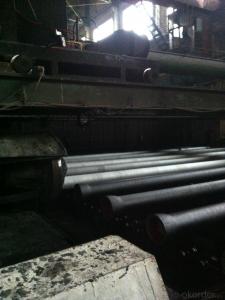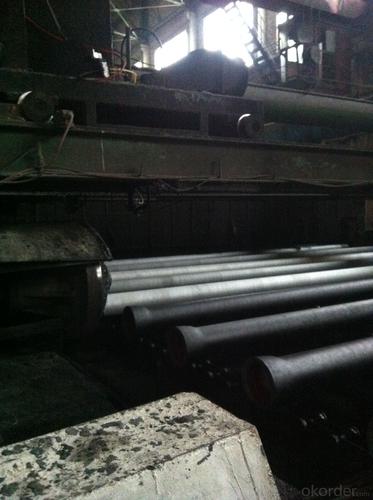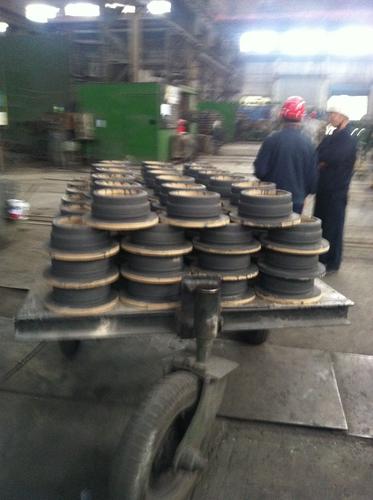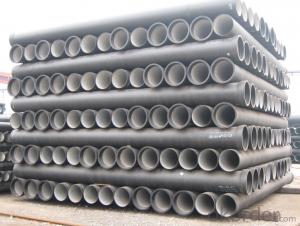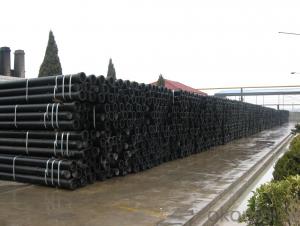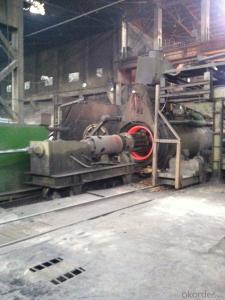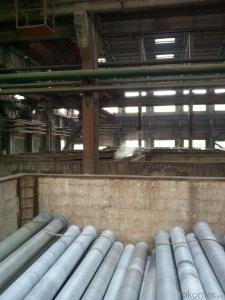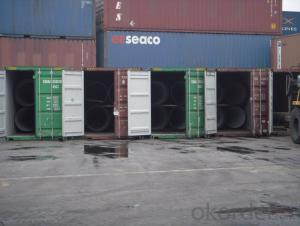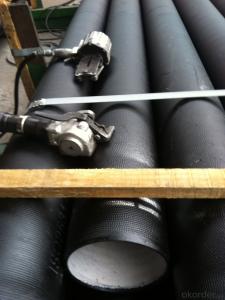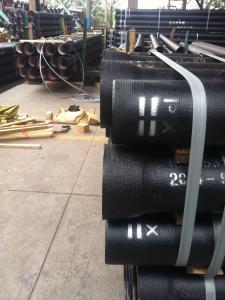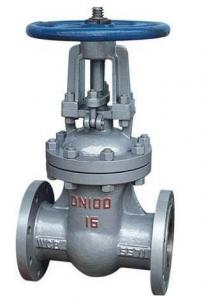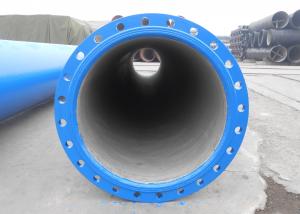DUCTILE IRON PIPES AND PIPE FITTINGS K9 DN450
- Loading Port:
- Tianjin
- Payment Terms:
- TT OR LC
- Min Order Qty:
- 25 m.t
- Supply Capability:
- 30000 m.t/month
OKorder Service Pledge
OKorder Financial Service
You Might Also Like
Material : Ductile Cast Iron
Size Range : DN 80mm to DN 2000mm
Unit Effective Length : 6m or 5.7m
Manufacture Standard: ISO 2531:1998/ EN 545:2006/EN 598:2007
Annual capacity : 200,000 tons
Coating Exterior: Zinc 130g/m2 according to ISO 8179-1 and bitumen coating 70 microns.
Cement Interior: Portland Cement/ High Alumina Cement/ Sulphate Resisting Cement Lining according to ISO 4179
Special requirements on external coating and internal lining can be applied
We also provide accessories such as SBR/EPDM rubber gaskets, lubricant paste, pipe caps, PE sleeves, etc.
Additional Parts:
Each pipe is strictly inspected according to related standard to ensure permanently high performance.
Easy Installation at site and service free for life
Long Service Lifespan
Quotation will arrive you within 24hours once we get your inquiry.
We guarantee offering you a competitive price.
A copy of original inspection reports of pipes will be offered after shipment.
Photos of loading process will be sent to the customer after shipment effect.
We will follow-up the delivery progress after shipment effect and update to the customer on weekly basis.
- Q: When the ductile iron pipe is pressed, the three links are always running out. What should be done?
- If the pipe is not laid, but installed outdoors, it is recommended to cement the pier and stabilize the pipe at the three and the pipe connection. The problem of the above situation lies in the pressure test in the open air, the outer wall of the pipe without the external pressure and the balance of internal pressure. Xin hot pipe industry
- Q: Can ductile iron pipe be used for geothermal heat exchange systems?
- Indeed, geothermal heat exchange systems can utilize ductile iron pipe. Renowned for its robustness and resilience, ductile iron pipe is perfectly suited to withstand the elevated temperatures and pressures typically found in such systems. Moreover, its exceptional resistance to corrosion is of utmost importance in geothermal applications, where minerals and chemicals present in the earth can induce corrosion. Additionally, the commendable thermal conductivity of ductile iron pipe facilitates efficient heat transfer within geothermal systems. In conclusion, ductile iron pipe stands as a dependable and economical option for geothermal heat exchange systems.
- Q: How does ductile iron pipe perform in areas with high groundwater levels?
- Ductile iron pipe performs exceptionally well in areas with high groundwater levels. One of the key advantages of ductile iron pipe is its corrosion resistance, which makes it highly suitable for underground applications and areas with high water tables. Unlike other materials, ductile iron pipe is not susceptible to rust or corrosion caused by groundwater, ensuring its durability and longevity. Furthermore, ductile iron pipe has excellent strength and flexibility, allowing it to withstand the external pressure exerted by high groundwater levels. It can resist the buoyant forces exerted by water, preventing it from floating or shifting out of place. In addition, ductile iron pipe's joints are tightly sealed, preventing any groundwater from infiltrating the pipe system. This ensures that there is no leakage or contamination of the water supply, which is crucial in areas with high groundwater levels. Overall, ductile iron pipe is the ideal choice for areas with high groundwater levels due to its corrosion resistance, strength, and ability to maintain a tight, secure system. It provides a reliable and long-lasting solution for water distribution and sewer systems, even in challenging environments.
- Q: Can ductile iron pipe be used for industrial process piping?
- Yes, ductile iron pipe can be used for industrial process piping. Ductile iron pipe is known for its strength, durability, and resistance to corrosion, making it a suitable choice for various industrial applications. It can handle high-pressure systems and is often used in industries such as water and wastewater treatment, oil and gas, chemical processing, and power generation. Additionally, ductile iron pipe is easy to install and has a long lifespan, making it a cost-effective option for industrial process piping.
- Q: How does ductile iron pipe perform in areas with high soil stability?
- Ductile iron pipe excels in areas characterized by high soil stability, as it possesses inherent strength and durability. This enables the pipe to withstand the soil's pressure without experiencing significant deformation or failure. The exceptional performance of ductile iron pipe is further bolstered by the minimal ground movements, settling, or shifting that is ensured by the stable soil conditions. In regions with high soil stability, the pipe is less susceptible to external forces or stresses that could potentially inflict damage. Ductile iron pipe exhibits remarkable resistance to corrosion, abrasion, and impact, rendering it highly suitable for such circumstances. The material's robustness allows it to endure the weight and pressure exerted by the soil, thereby guaranteeing the pipe's structural integrity over time. Furthermore, the flexibility and joint design of ductile iron pipe contribute to its performance in areas with high soil stability. The pipe's capacity to accommodate slight movements and minor ground shifts without compromising its integrity is advantageous in these stable soil conditions. The restrained joint system utilized in ductile iron pipe installations provides added support and stability, thereby minimizing the risk of pipe dislocation or failure. All in all, ductile iron pipe is a dependable and efficient choice for areas characterized by high soil stability. Its strength, durability, and resistance to external forces equip it to handle the demands of such environments. Additionally, the pipe's flexibility and joint design enable it to adapt to minor soil movements, thereby further enhancing its performance in these conditions.
- Q: How does ductile iron pipe perform in areas with high ground movement?
- Ductile iron pipe performs well in areas with high ground movement due to its inherent flexibility and strength. Its ability to bend and absorb ground movements makes it less susceptible to cracking or breaking compared to other rigid pipe materials. Additionally, the material's high tensile strength and durability ensure that it can withstand the stresses caused by ground movement without compromising its structural integrity.
- Q: Why does the construction wastewater system use ductile iron pipes instead of galvanized steel tubes?
- The cost is low, the construction cost is low, and the schedule is fast. Such as PVC, PE double wall corrugated pipes, etc..
- Q: What are the different types of valves available for ductile iron pipe?
- Ductile iron pipe offers a variety of valve options, each with its own unique purpose and function. Among the most commonly used valves are: 1. Gate Valves: These valves are designed to either fully open or fully close the fluid flow in the pipe. They feature a gate-like mechanism that permits or blocks the passage of fluid depending on the valve's position. 2. Butterfly Valves: Butterfly valves are quarter-turn valves that utilize a circular disc to control the flow. When open, the disc aligns parallel to the flow, resulting in minimal pressure drop. Conversely, when closed, the disc aligns perpendicular to the flow, effectively stopping the fluid. 3. Ball Valves: Ball valves consist of a spherical disc with a central hole, known as a ball. When the valve is open, the ball is positioned to allow fluid to pass through the hole. To close the valve, the ball is rotated to obstruct the flow. 4. Check Valves: Check valves are specifically designed to permit fluid flow in one direction only, preventing backflow. They incorporate a flap or disc that opens when the flow is in the correct direction and closes to halt the flow when reversal occurs. 5. Plug Valves: Plug valves feature a cylindrical or conical plug with a through-hole that can be rotated to regulate the flow. When open, the hole aligns with the pipe, enabling fluid to pass. Closing the valve positions the hole perpendicular to the pipe, blocking the flow. 6. Pressure Reducing Valves: These valves serve the purpose of controlling and reducing the pressure of fluid within the pipe. They employ a mechanism that adjusts the flow area to achieve pressure reduction. 7. Pressure Sustaining Valves: Pressure sustaining valves are utilized to maintain a specific pressure level within the pipe. They automatically adjust the flow area to sustain the desired pressure. 8. Air Release Valves: Air release valves are employed to eliminate trapped air within the pipe. They allow air to escape while preventing fluid leakage. These examples demonstrate the diverse range of valve options available for ductile iron pipe. The selection of a suitable valve depends on factors such as the application, flow requirements, and desired functionality.
- Q: How can the ductile iron pipe be tested?
- The pipeline of water supply pipeline in winter pressure test, must have the corresponding prevention measures, antifreeze, then should give water pipes in the filling should be appropriate in some high, then the protective material for a little more to the interface covered.
- Q: What are the different types of linings available for ductile iron pipe?
- There are several different types of linings available for ductile iron pipe, each with its own advantages and applications. 1. Cement mortar lining: This is one of the most common linings used for ductile iron pipes. It consists of a layer of cement mortar applied to the interior surface of the pipe. Cement mortar lining provides excellent resistance to corrosion and chemical attack, making it suitable for a wide range of applications, including potable water distribution, wastewater conveyance, and industrial pipelines. It also helps to reduce friction and turbulence within the pipe, improving flow efficiency. 2. Polyethylene lining: Polyethylene linings are often used in ductile iron pipes for applications where corrosion resistance is a primary concern. This lining consists of a layer of high-density polyethylene (HDPE) that is either extruded or sprayed onto the pipe's inner surface. Polyethylene lining provides superior resistance to corrosion, abrasion, and chemical attack, making it ideal for transporting aggressive fluids, such as saltwater, chemicals, or industrial waste. 3. Polyurethane lining: Polyurethane linings are commonly used in ductile iron pipes for applications where enhanced protection against abrasive wear is required. This lining is formed by spraying or pouring a layer of polyurethane onto the inner surface of the pipe. Polyurethane lining offers excellent resistance to abrasion, impact, and chemical attack, making it suitable for conveying abrasive slurries, mining applications, and other high-wear environments. 4. Epoxy lining: Epoxy linings are applied to ductile iron pipes to provide a protective barrier against corrosion and chemical attack. This lining is typically formed by applying a layer of epoxy resin to the pipe's inner surface through a process known as centrifugal casting or electrostatic spraying. Epoxy lining offers excellent adhesion and resistance to corrosion, making it suitable for various applications, including potable water distribution, wastewater treatment, and industrial pipelines. 5. Zinc lining: Zinc linings are used in ductile iron pipes to provide cathodic protection against corrosion. This lining involves applying a layer of zinc to the pipe's inner surface, either through hot-dip galvanizing or by electroplating. Zinc lining acts as a sacrificial anode, corroding preferentially to the iron pipe and protecting it from corrosion. It is commonly used in applications where the pipe is exposed to highly corrosive environments, such as seawater or acidic soils. Overall, the choice of lining for ductile iron pipes depends on the specific requirements of the application, including the type of fluid being transported, the level of corrosion resistance needed, and the potential for abrasive wear. Consulting with industry experts and considering factors such as cost, longevity, and maintenance requirements can help determine the most suitable lining option for a particular project.
Send your message to us
DUCTILE IRON PIPES AND PIPE FITTINGS K9 DN450
- Loading Port:
- Tianjin
- Payment Terms:
- TT OR LC
- Min Order Qty:
- 25 m.t
- Supply Capability:
- 30000 m.t/month
OKorder Service Pledge
OKorder Financial Service
Similar products
Hot products
Hot Searches
Related keywords
